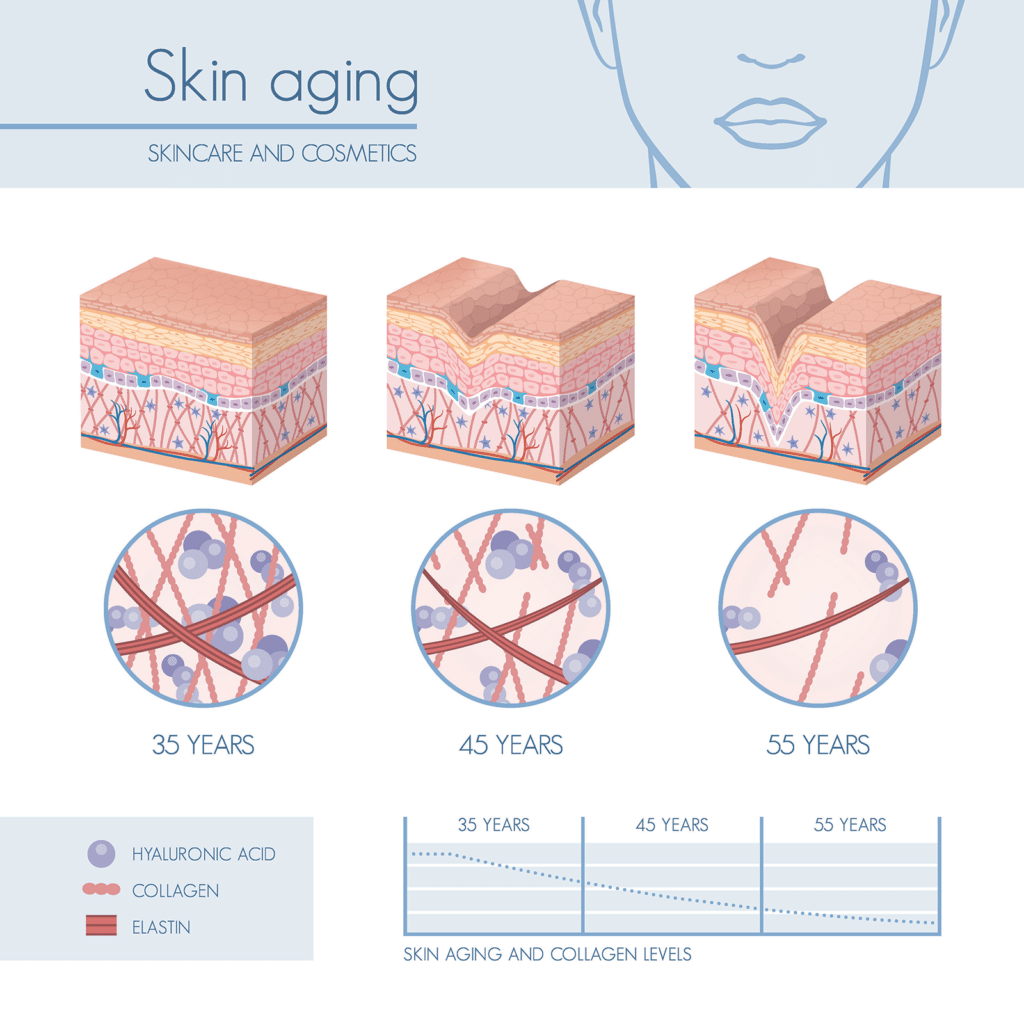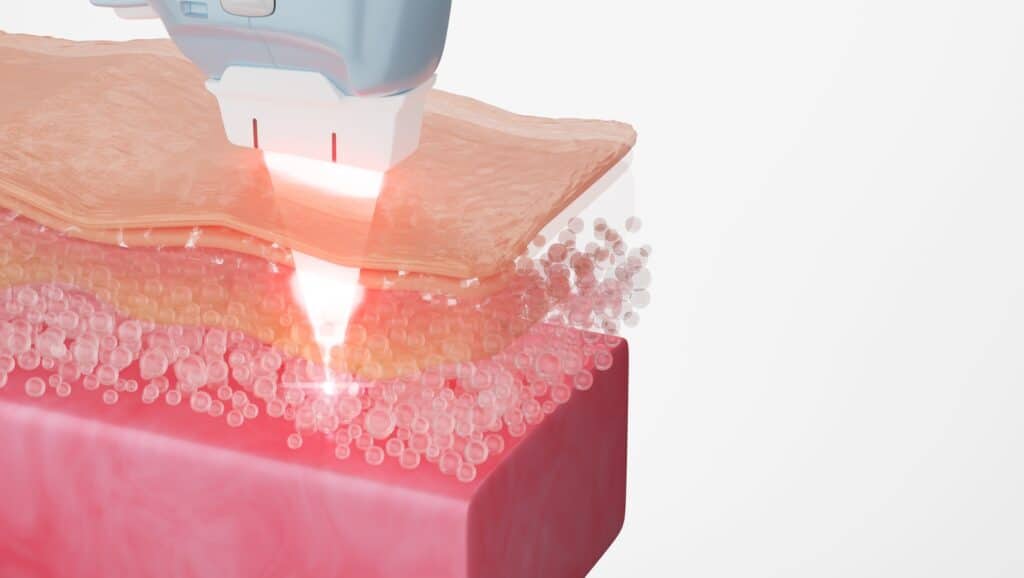Explore the science, benefits, and ways to boost your collagen for healthier skin and body.
Collagen powder, capsules, in creams or as an ingredient in food – COLLAGEN IS EVERYWHERE! This not only applies to the media, but also to our bodies. Collagen is an important building block in bones, tendons, ligaments and our favorite organ (and our focus organ): the skin. It makes up 75% of the dry weight of our skin.
What is Collagen?
Collagen is a structural protein. It consists of several amino acids that are strung together in chains. Important amino acids here are glycine and proline. Three of these amino acid chains are twisted together to form a triple helix, which is known as a collagen fiber. There are 28 different types of collagen, 11 of which are found in our skin [1, 2].

What is collagen good for?
Collagen supports body structures and is essential for wound healing. As we get older, the proportion of collagen decreases and existing fibers also change [3]. Signs in the skin include increased vulnerability as well as permanent wrinkles, loss of volume and loss of skin quality. It is therefore no wonder that scientists are investigating how we can support our body in collagen production.
Fibroblasts are responsible for collagen production in our skin. They are located in the dermis, the second layer of skin. Their activity gives the dermis a gel-like structure, which ensures the health of other cells, strengthens the connection to the epidermis and gives our skin elasticity and stretchability. MMPs (matrix metallo-proteases) break down old collagen and make room for new collagen – creating a balance of build-up and breakdown for the optimal condition of our skin [4].
What is collagen banking?
For a healthy and youthful appearance with the popular glow, we need fresh collagen. Fresh collagen comes from powerful fibroblasts – so it pays to start early. This is known as collagen banking. Collagen is “saved up” at a time when you have a lot, all fibroblasts are active and the quality of the fibers is good. It is not actually the case that collagen is “put aside” like money in a bank. It is much more the case that the level of well-cross-linked and tissue-densifying collagen is not allowed to fall too low in the first place. There is no predefined age defined by science – but an initial change in skin quality, firmness or resistance are good indicators.
Is collagen vegan? What is collagen made of?
Collagen is found in both humans and animals. So if you use collagen for creams, food supplements and the like, it is always an animal product. Collagen is usually obtained from slaughterhouse waste, such as hooves or cartilage, but marine collagen, for example from fish skin, is also available on the market. Some processes involve extraction from eggshell membrane, which is marketed as vegetarian collagen.
There is no such thing as vegan collagen. When we talk about “vegan collagen”, we are referring to peptides. These are building blocks that the body needs to produce its own collagen.
Supporting collagen production, or filling collagen gaps from the outside, is an important part of maintaining skin health and vitality [5]. But how does additional collagen get into the skin? There are various approaches.
How can I increase the natural collagen content of my skin? Food supplements
Collagen powder, capsules or drinks are available on the market and can be taken directly as a dietary supplement. When it comes to food supplements, the natural question is: What is absorbed by the skin and what is digested? Or: How much collagen should I take?
Various studies have examined the skin before and after taking collagen.
Studies on the intake of collagen with a positive effect on the skin, joints or recovery phase after sport usually range from 2.5 g to 10 g of collagen per day [6-8].
Studies show an improvement in skin hydration, skin density and skin elasticity when used daily for 4 weeks or more [6, 9-12]. Examinations of the skin under the microscope revealed an increased number of fibroblasts, the cells that produce collagen, and also an improved skin structure [7]. Inflammatory reactions and redness of the skin were also reduced.
Test subjects in the studies rated the results as positive and found taking the product to be uncomplicated and feasible in everyday life [13]. This is the basis for a reliable and long-term decision.
Minerals, trace elements and vitamins are often added to collagen supplements to enhance the effect of the collagen. It is therefore advisable to take them according to the manufacturer’s instructions or the package leaflet.
How can I increase the natural collagen content of my skin? Microneedling
Collagen is essential for wound healing in our skin. When we injure ourselves, the cells in our skin break down the injured cells and rebuild tissue. Unfortunately, reconstruction does not always proceed smoothly and scars can occur. With microneedling, the skin is injured in a targeted and controlled manner [14]. As collagen plays a key role in the wound healing process and collagen production is stimulated by the micro-injury, microneedling is also referred to as “collagen induction therapy”, or CIT for short. Due to the many small punctures, the skin has enough incentive to react to the injury, but at the same time it does not have the stress that would be the case with a “real” injury, such as dirt or loss of skin. All skin structures remain intact during microneedling. The connection between the epidermis and subcutis is therefore still present [14, 15].
This is important because many growth processes take place in this connection zone. The epidermis is stimulated to divide cells. At the same time, the connection between the epidermis and subcutis is strengthened. This connection is important as the epidermis does not have its own blood supply and is dependent on the supply of nutrients from the subcutis. A better connection therefore leads to an improved supply and thus to a healthier and more vital epidermis. The cells of the subcutis are also activated by the micro-injuries to the skin. The collagen-forming cells are stimulated by the injury and produce new fibrous tissue [16]. The fresh collagen binds moisture and provides a healthier cell environment for the subcutaneous cells. On the surface, we see a long-term improvement in skin structure and elasticity, which reduces the appearance of wrinkles [17]. Also stimulated by microneedling, outdated collagen structures in the skin are broken down. This process is important as outdated collagen fibers “clump together” and no longer provide ideal support for the tissue. Microneedling therefore has a lasting effect on the tissue structure of the skin and thus rejuvenates it [14, 16]. The results after a treatment also show a high level of patient satisfaction, which is an important factor in the field of aesthetics [17].
As the mechanism of microneedling does not require any “external” collagen and active ingredients can, but do not have to, be introduced to achieve the desired effect, the treatment can be used for almost all skin types.
How can I increase the natural collagen content of my skin? Laser, radio frequency and co.
As with microneedling, other techniques also focus on the targeted destruction and orderly restoration of collagen in the tissue. For example, the use of lasers and radiofrequency. Depending on the type of laser treatment, small holes are made in the skin (fractional laser) or the entire skin is “removed” from above (ablative laser). The skin is injured thermally, i.e. by temperature, and the dead tissue is removed from the cells and the collagen is stimulated by the triggered wound healing [18].

The fractional laser procedure is visually very interesting, as the skin “contracts” under the influence of the laser beams, while at the same time no blood is visible due to the heat. This effect makes it popular on social media and numerous videos of the treatments can be seen on Instagram and TikTok. After the treatment, scabs form on the skin and coagulation points are created in the tissue; tissue has been “burned”. This must then be processed and renewed by the skin, which is where the formation of collagen comes into play. The result is only visible after the tissue has regenerated and the so-called “downtime”, which can include redness, swelling and a feeling of heat, depending on the sensitivity. With ablative lasers, particular attention must be paid to the transitions: As skin has been removed and rebuilt, the change to the original skin is often striking.
Salmon sperm, biostimulators and co – Which injection brings collagen into the tissue?
A lot is also being done in the field of injectables to promote collagen. Pure collagen is not usually injected because reactions have occurred more frequently in the past and there are more modern substances that can stimulate the body’s own production. Hyaluronic acid, calcium hydroxyapatite or salmon sperm – it is important to understand that collagen stimulation injections are not simply to fill a wrinkle – they are to stimulate the skin to regenerate and are used as biostimulants [19-21].
Hyaluronic acid, for example, is a versatile injection substance and also an important component of the subcutis. Injections of hyaluronic acid can improve the cell environment of the collagen-forming cells and thus stimulate the activation of collagen production [20]. In the field of biostimulants, there are also substances that target the continuous cell-cell communication and activation of the cells in the subcutis through targeted “commands”. These include exosomes. Other substances achieve the goal of stimulation through their properties as a substance, i.e. how liquid or solid they are and how they behave in the tissue [22, 23].
Collagen is important for our body, our health and also the youthfulness of our skin. What do you do to support your collagen balance?
1. Kerscher M, Williams S, Trüeb RM. Dermatokosmetik. Heidelberg: Steinkopff; 2009.
2. Rittié L, Fisher GJ. Natural and sun-induced aging of human skin. Cold Spring Harb Perspect Med. 2015;5:a015370. doi:10.1101/cshperspect.a015370.
3. Panwar P, Butler GS, Jamroz A, Azizi P, Overall CM, Brömme D. Aging-associated modifications of collagen affect its degradation by matrix metalloproteinases. Matrix Biol. 2018;65:30–44. doi:10.1016/j.matbio.2017.06.004.
4. Quan T. Molecular insights of human skin epidermal and dermal aging. J Dermatol Sci. 2023;112:48–53. doi:10.1016/j.jdermsci.2023.08.006.
5. Asserin J, Lati E, Shioya T, Prawitt J. The effect of oral collagen peptide supplementation on skin moisture and the dermal collagen network: evidence from an ex vivo model and randomized, placebo-controlled clinical trials. J Cosmet Dermatol. 2015;14:291–301. doi:10.1111/jocd.12174.
6. Miranda RB de, Weimer P, Rossi RC. Effects of hydrolyzed collagen supplementation on skin aging: a systematic review and meta-analysis. Int J Dermatol. 2021;60:1449–61. doi:10.1111/ijd.15518.
7. Czajka A, Kania EM, Genovese L, Corbo A, Merone G, Luci C, Sibilla S. Daily oral supplementation with collagen peptides combined with vitamins and other bioactive compounds improves skin elasticity and has a beneficial effect on joint and general wellbeing. Nutr Res. 2018;57:97–108. doi:10.1016/j.nutres.2018.06.001.
8. Khatri M, Naughton RJ, Clifford T, Harper LD, Corr L. The effects of collagen peptide supplementation on body composition, collagen synthesis, and recovery from joint injury and exercise: a systematic review. Amino Acids. 2021;53:1493–506. doi:10.1007/s00726-021-03072-x.
9. Bolke L, Schlippe G, Gerß J, Voss W. A Collagen Supplement Improves Skin Hydration, Elasticity, Roughness, and Density: Results of a Randomized, Placebo-Controlled, Blind Study. Nutrients 2019. doi:10.3390/nu11102494.
10. Kim D-U, Chung H-C, Choi J, Sakai Y, Lee B-Y. Oral Intake of Low-Molecular-Weight Collagen Peptide Improves Hydration, Elasticity, and Wrinkling in Human Skin: A Randomized, Double-Blind, Placebo-Controlled Study. Nutrients 2018. doi:10.3390/nu10070826.
11. Evans M, Lewis ED, Zakaria N, Pelipyagina T, Guthrie N. A randomized, triple-blind, placebo-controlled, parallel study to evaluate the efficacy of a freshwater marine collagen on skin wrinkles and elasticity. J Cosmet Dermatol. 2021;20:825–34. doi:10.1111/jocd.13676.
12. Proksch E, Segger D, Degwert J, Schunck M, Zague V, Oesser S. Oral supplementation of specific collagen peptides has beneficial effects on human skin physiology: a double-blind, placebo-controlled study. Skin Pharmacol Physiol. 2014;27:47–55. doi:10.1159/000351376.
13. Laing S, Bielfeldt S, Ehrenberg C, Wilhelm K-P. A Dermonutrient Containing Special Collagen Peptides Improves Skin Structure and Function: A Randomized, Placebo-Controlled, Triple-Blind Trial Using Confocal Laser Scanning Microscopy on the Cosmetic Effects and Tolerance of a Drinkable Collagen Supplement. J Med Food. 2020;23:147–52. doi:10.1089/jmf.2019.0197.
14. Aust MC, Des Fernandes, Kolokythas P, Kaplan HM, Vogt PM. Percutaneous collagen induction therapy: an alternative treatment for scars, wrinkles, and skin laxity. Plast Reconstr Surg. 2008;121:1421–9. doi:10.1097/01.prs.0000304612.72899.02.
15. Badran MM, Kuntsche J, Fahr A. Skin penetration enhancement by a microneedle device (Dermaroller) in vitro: dependency on needle size and applied formulation. Eur J Pharm Sci. 2009;36:511–23. doi:10.1016/j.ejps.2008.12.008.
16. Liebl H, Kloth LC. Skin cell proliferation stimulated by microneedles. J Am Coll Clin Wound Spec. 2012;4:2–6. doi:10.1016/j.jccw.2012.11.001.
17. Alqam M, Wamsley CE, Hitchcock T, Jones BC, Akgul Y, Kenkel JM. Efficacy and Tolerability of a Microneedling Device for Treating Wrinkles on the Neck. Aesthet Surg J. 2022;42:1154–60. doi:10.1093/asj/sjac085.
18. Pour Mohammad A, Gholizadeh Mesgarha M, Seirafianpour F, Karimi Y, Sodagar S, Afraie M, Goodarzi A. A systematic review and meta-analysis of efficacy, safety, and satisfaction rates of laser combination treatments vs laser monotherapy in skin rejuvenation resurfacing. Lasers Med Sci. 2023;38:228. doi:10.1007/s10103-023-03856-5.
19. Goldie K, Chernoff G, Corduff N, Davies O, van Loghem J, Viscomi B. Consensus Agreements on Regenerative Aesthetics: A Focus on Regenerative Biostimulation With Calcium Hydroxylapatite. Dermatol Surg. 2024;50:S172-S176. doi:10.1097/DSS.0000000000004437.
20. van Loghem J, Sattler S, Casabona G, Cotofana S, Fabi SG, Goldie K, et al. Consensus on the Use of Hyaluronic Acid Fillers from the Cohesive Polydensified Matrix Range: Best Practice in Specific Facial Indications. Clin Cosmet Investig Dermatol. 2021;14:1175–99. doi:10.2147/CCID.S311017.
21. Wit A de, Siebenga PS, Wijdeveld RW, Koopmans PC, van Loghem JAJ. A split-face comparative performance evaluation of injectable hyaluronic acid-based preparations HCC and CPM-HA20G in healthy females. J Cosmet Dermatol. 2022;21:5576–83. doi:10.1111/jocd.15157.
22. Xiong M, Zhang Q, Hu W, Zhao C, Lv W, Yi Y, et al. The novel mechanisms and applications of exosomes in dermatology and cutaneous medical aesthetics. Pharmacol Res. 2021;166:105490. doi:10.1016/j.phrs.2021.105490.
23. Le Ngoc TN, Moon J-Y, Lee Y-C. Utilization of light-emitting diodes for skin therapy: Systematic review and meta-analysis. Photodermatol Photoimmunol Photomed. 2023;39:303–17. doi:10.1111/phpp.12841.
